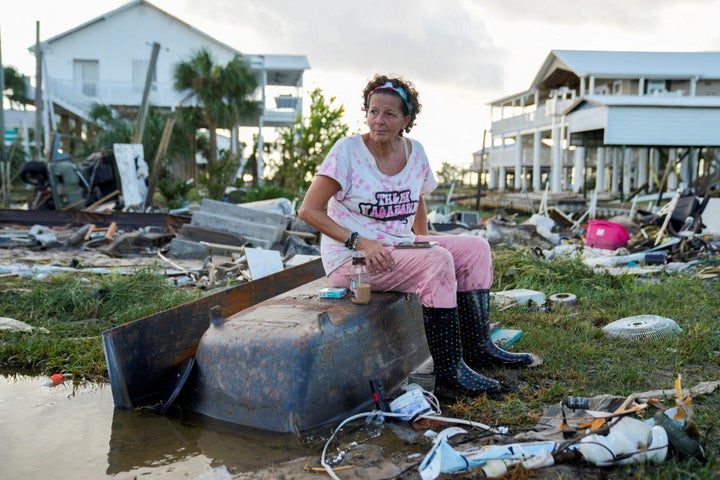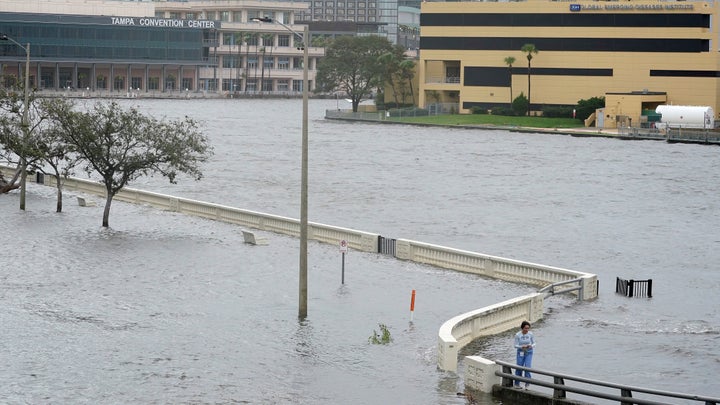Hurricane Idalia rapidly intensified before striking Florida — a phenomenon that’s become alarmingly common as the planet warms.
On Tuesday night, as Hurricane Idalia barreled toward Florida’s coast, Fox News host Jesse Waters teased his next guest, calling her “the nation’s most famous climate scientist.” Unsurprisingly to anyone following the right-wing climate denial movement, his guest was Judith Curry, a retired climatologist who dismisses that human activity drives current planetary warming and has become a go-to figure in conservative circles.
What followed was nearly seven minutes of Waters and Curry peddling misinformation about the realities of climate change and its mounting impacts. Curry declared — falsely — that “there is no evidence this is leading to worse weather events.” On the side of the screen throughout her interview, a storm tracker kept Fox viewers updated about Hurricane Idalia’s track and wind speeds.
No single hurricane can be solely attributed to climate change, and scientists are careful to steer clear of such declarations. But Idalia has all the signs of a storm supercharged by climate breakdown — the type of event that is expected to become increasingly common in a warming world.
Tropical storms are fueled largely by warm water. The Gulf of Mexico is amid a relentless marine heat wave. Earlier this month, waters in the Gulf reached their hottest on record — an average of 88 degrees Fahrenheit.
As Idalia churned over the blistering Gulf and took aim at Florida earlier this week, it underwent what’s known as “rapid intensification” — a phenomenon in which a cyclone’s maximum sustained winds increase at least 35 mph in a 24-hour period. From Tuesday morning into Wednesday, Idalia exploded from a Category 1 to a Category 4 hurricane, with wind speeds spiking 55 mph in a 24-hour period.
Idalia ultimately weakened slightly to a Category 3 before making landfall Wednesday near Keaton Beach, Florida, but its violent growth before that mirrors the kind of hurricane activity that scientists say is becoming more frequent as climate change drives up ocean temperatures.
“I’ve seen this signature way too much during the past several years — rapid intensification before U.S. landfall,” Eric Blake, a senior hurricane specialist at the National Hurricane Center, wrote in a post to X, formerly Twitter. “#Idalia is showing all the bad signs, and that all-too-familiar pit-in-the-stomach feeling is back.”

Idalia is one of just 10 storms since 1950 to intensify at least 40 mph in a single day before making landfall, joining the likes of Hurricanes Ida in 2021, Laura in 2020 and Michael in 2018, as Jeff Masters, a former federal hurricane scientist who now works for Yale Climate Connections, pointed out in a tweet.
“Sobering to see five of those storms occurred in the past seven years,” he wrote Wednesday. “Climate change increases the odds of rapid intensification.”
In a subsequent post on Yale Climate Connections’ website, Masters made the case that increased sea surface temperatures from anthropogenic climate change “led to a 40-50% increase in Idalia’s destructive power by increasing the hurricane’s winds by at least 4-5%.”
“A 4-5% increase in hurricane winds may not seem like a big deal, but damage from a hurricane increases exponentially with an increase in winds,” he wrote. “For example, according to [the National Oceanic and Atmospheric Administration], a Category 2 hurricane with 100 mph winds will do 10 times the damage of a Category 1 hurricane with 75 mph winds. This includes damage not only from winds, but also from storm surge, inland flooding, and tornadoes.”
Scientists have long warned about the link between climate change and extreme hurricanes.
The 2018 National Climate Assessment, a congressionally mandated report, concluded, “increases in greenhouse gasses and decreases in air pollution have contributed to increases in Atlantic hurricane activity since 1970” and that “in the future, Atlantic and eastern North Pacific hurricane rainfall and intensity are projected to increase.” A 2020 federal study analyzed satellite data over a 40-year period and found that planetary warming increased the likelihood of a tropical cyclone becoming a major hurricane ― Category 3 strength or higher ― by approximately 8% per decade. A landmark United Nations report in 2021 concluded that climate change is driving “an increase in the proportion of intense tropical cyclones” and that “the proportion of intense tropical cyclones (Category 4–5) and peak wind speeds of the most intense tropical cyclones are projected to increase at the global scale with increasing global warming.”

Asked about the link on Wednesday, Federal Emergency Management Agency Administrator Deanne Criswell told reporters that elevated ocean heat has fueled more extreme cyclones in recent years.
“These storms are intensifying so fast that our local emergency management officials have less time to warn and evacuate and get people to safety,” Criswell said. “This is something that we have to take into consideration as we build our preparedness plans, as our local communities build their preparedness plans, and how they’re going to communicate and prepare their communities for the types of storms that they’re going to face in the future.”
Yet on Wednesday evening, as much of Florida was reeling from the impacts of Idalia, including widespread flooding, the state’s chief resilience officer, Wesley Brooks, took to X in an attempt to throw cold water on the science.
“Interesting to note that when it comes to major landfalling hurricanes in FL, there appears to be NO MEANINGFUL TREND OVER TIME for max sustained winds or low pressure (ie, hurricane intensity),” he wrote.
The devastation from Idalia comes just a few months after Florida Gov. Ron DeSantis (R) rejected more than $350 million in federal clean energy and climate funding from President Joe Biden’s signature climate law, the Inflation Reduction Act. Meanwhile, Florida’s Department of Education recently approved tusingclimate change denial videos and materials in classrooms, E&E reported. And for weeks, DeSantis has remained silent about another climate and economic disaster in his home state: The mass bleaching of coral reefs in the Florida Keys.
Credit: Source link